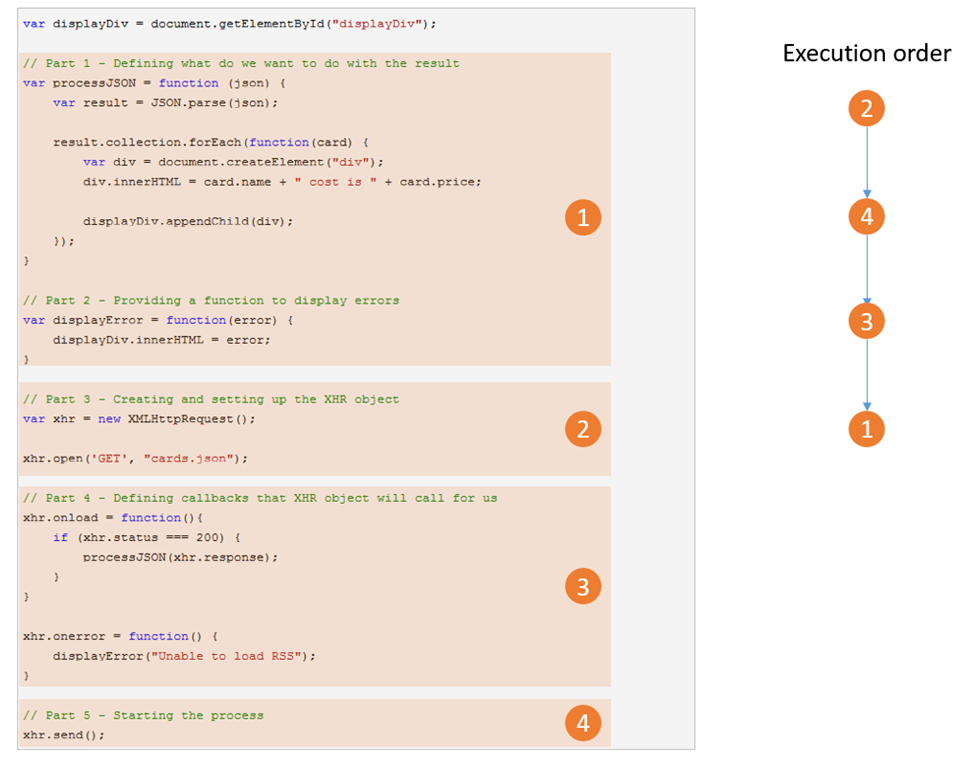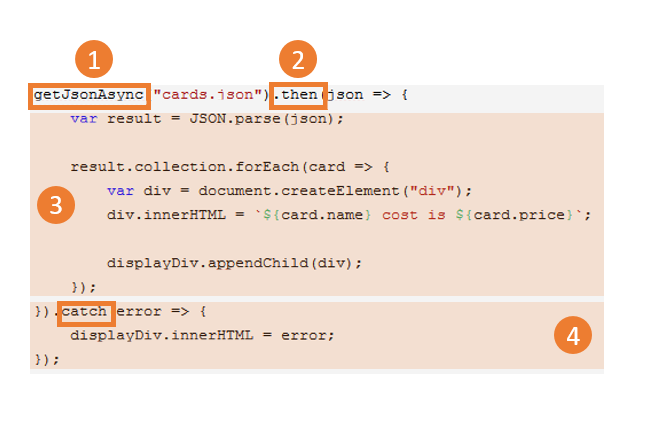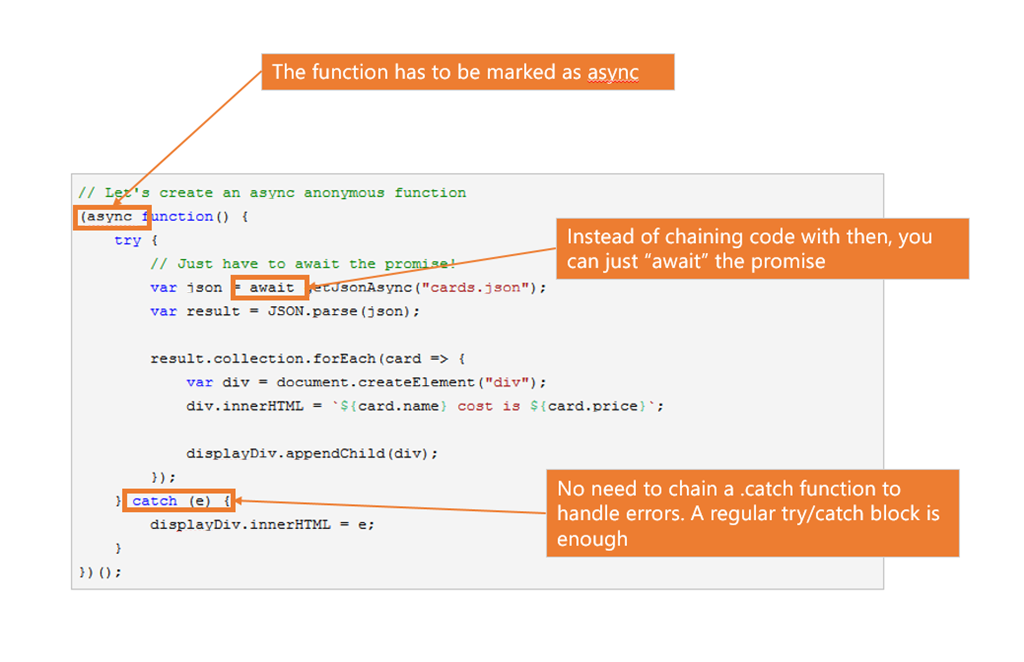此文来自微软web开发系列。
JavaScript自从诞生之日起,经历了漫长的演变过程。今天,这门语言被我们广泛使用,主要得感谢TC39对于JavaScript(即ECMAScript)标准化所付出的努力。
ECMAScript在发展过程中得到的巨大提升之一就是关于异步处理。如果你是这方面的新手,可以从asynchronous programming here学到不少。幸运的是,在Windows 10的新一代Edge浏览器中,我们已经包含了这些特性,具体变化你可以查看Microsoft Edge change log。
##第一步: ECMAScript 5 —— Callback ECMAScript 5以及之前的版本,都采用了callback的方式。为了更好地说明这一点,我们煮个简单的栗子,比如你基本上天天都会用到的:发起一个XHR请求。
var displayDiv = document.getElementById("displayDiv");
// Part 1 - Defining what do we want to do with the result
var processJSON = function (json) {
var result = JSON.parse(json);
result.collection.forEach(function(card) {
var div = document.createElement("div");
div.innerHTML = card.name + " cost is " + card.price;
displayDiv.appendChild(div);
});
}
// Part 2 - Providing a function to display errors
var displayError = function(error) {
displayDiv.innerHTML = error;
}
// Part 3 - Creating and setting up the XHR object
var xhr = new XMLHttpRequest();
xhr.open('GET', "cards.json");
// Part 4 - Defining callbacks that XHR object will call for us
xhr.onload = function(){
if (xhr.status === 200) {
processJSON(xhr.response);
}
}
xhr.onerror = function() {
displayError("Unable to load RSS");
}
// Part 5 - Starting the process
xhr.send();
有经验的JavaScript开发者看到这些算是再熟悉不过了:首先创建一个XHR请求对象,再给其相应的属性绑定callback函数。
相比之下,callback方式复杂的成因,主要来源于由于异步代码与生俱来的非线性执行顺序:
 并且,最可怕的莫过于“回调地狱”(callbacks hell),即在一个callback中发起另一个callback。
并且,最可怕的莫过于“回调地狱”(callbacks hell),即在一个callback中发起另一个callback。
##第二步: ECMAScript 6 —— Promise ECMAScript 6势头正旺,Edge目前已经覆盖到其特性的88%。特性详情请戳我
在众多提升中,ECMAScript 6对Promise的使用进行了标准化(之前被称作future)。 根据MDN所述,promise是一个用于延迟和异步进行计算的对象。一个promise代表了一个尚未完成,但是被期望在未来某个时间完成的操作。异步操作经过Promise的组织后,可以表现为同步操作的形式。Promise已经存在了一段时间,好消息是,你现在已经无需用到任何的库,因为浏览器已经开始支持它。
我们来使用Promise更新一下之前的例子,看看它是如何提高代码的可读性和可维护性。
var displayDiv = document.getElementById("displayDiv");
// Part 1 - Create a function that returns a promise
function getJsonAsync(url) {
// Promises require two functions: one for success, one for failure
return new Promise(function (resolve, reject) {
var xhr = new XMLHttpRequest();
xhr.open('GET', url);
xhr.onload = () => {
if (xhr.status === 200) {
// We can resolve the promise
resolve(xhr.response);
} else {
// It's a failure, so let's reject the promise
reject("Unable to load RSS");
}
}
xhr.onerror = () => {
// It's a failure, so let's reject the promise
reject("Unable to load RSS");
};
xhr.send();
});
}
// Part 2 - The function returns a promise
// so we can chain with a .then and a .catch
getJsonAsync("cards.json").then(json => {
var result = JSON.parse(json);
result.collection.forEach(card => {
var div = document.createElement("div");
div.innerHTML = `${card.name} cost is ${card.price}`;
displayDiv.appendChild(div);
});
}).catch(error => {
displayDiv.innerHTML = error;
});
你可以在这段代码中看到诸多提升,我们来细细分析下。
###建立Promise
首先,你要建立一个promise对象,去“包装”古老的XHR。

###使用promise
一旦建立之后,可以采用优雅地对异步操作进行链式调用:

现在,从我们的角度来看,做了如下事情。
- 获得Promise(1)
- 链接到处理成功时需要执行的代码(2和3)
- 用try/catch链接到处理错误时需要执行的代码(4)
只需要傻傻地调用.then().then()就可以将多个promise“串连”起来,是不是很有趣?
tips:由于JavaScript是一门现代语言,你可能已经注意到我使用了ECMAScript 6中的一些语法糖(syntax sugar),例如模板字符串(template strings)和箭头函数(arrow functions)。
##终点: ECMAScript 7 —— 无处不在的异步 最后,我们终于达到了和异步“融为一体”的目的!得益于Edge浏览器的快速迭代,开发团队已经在最新版本中引进了ECMAScript 7中的异步函数(async function)!
异步函数的实现基于ECMAScript 6中的特性,例如生成器(generator)。generator确实能和promise协作,从而产生同样的效果,可是却需要写更多的代码。有了异步函数,我们只需要将之前的例子改为:
// Let's create an async anonymous function
(async function() {
try {
// Just have to await the promise!
var json = await getJsonAsync("cards.json");
var result = JSON.parse(json);
result.collection.forEach(card => {
var div = document.createElement("div");
div.innerHTML = `${card.name} cost is ${card.price}`;
displayDiv.appendChild(div);
});
} catch (e) {
displayDiv.innerHTML = e;
}
})();
这串代码的神奇之处就在于,它的执行逻辑看起来就是同步的,有着完美的线性执行顺序。

最后,读到这里,难道你还没有被深深地震撼到?不但如此,异步函数也可以用于箭头函数以及类方法。

